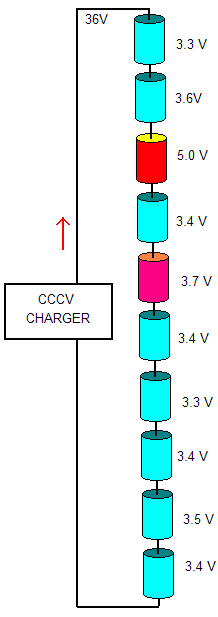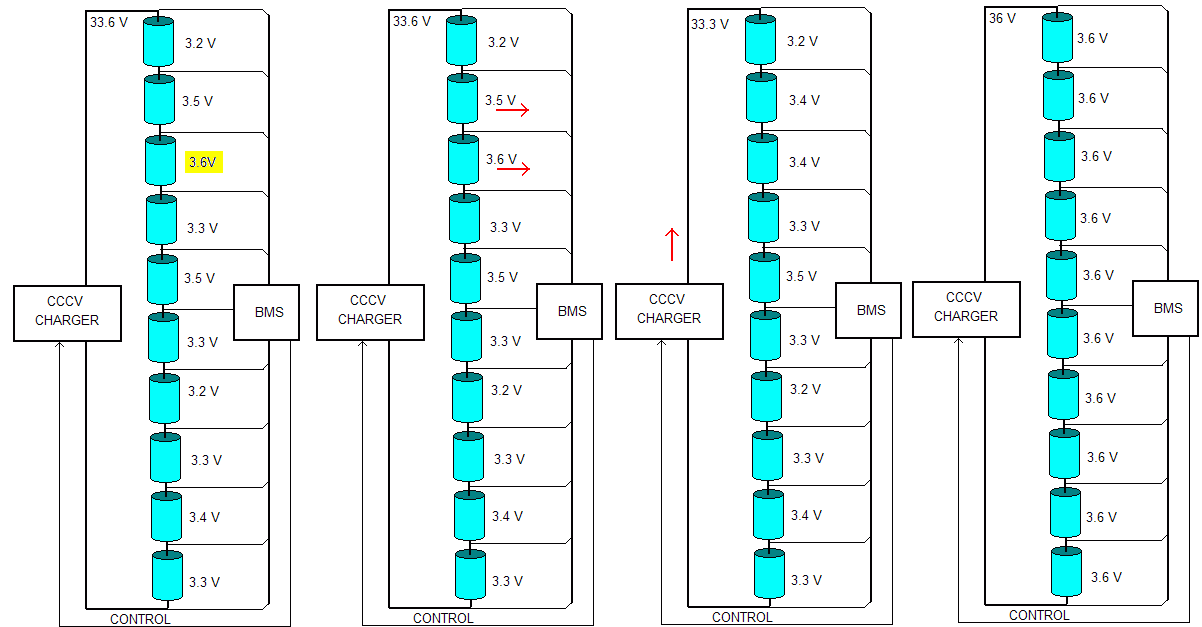 Li-Ion BMS
Li-Ion BMS
|
Home White Paper - CCCV chargers: a false sense of security Without a BMS, a CCCV charger will overcharge cells in an high voltage battery pack 
A CCCV (Constant Current, Constant Voltage) is ideal for small batteries. Initially, the battery is charged at Constant Current. When the battery is nearly full, its voltage reaches the Constant Voltage setting of the charger, and the current decays exponentially as the battery gets a finishing charge. In a small battery, the charger voltage is divided pretty much equally among the cells within it. For example, when charging a car battery, the Constant Voltage of 13.5 V is applied to the 12 V battery, each of the 6 cells within it getting about 2.25 V. If any cell is more charged, its voltage will be a bit higher, taking away some voltage from the other cells: for example, if one cell is at 2.5 V, the other cells will be, on the average, at 2.20 V. In a high voltage battery, though, one with many cells in series, there is a much greater chance that the overall pack voltage is not evenly divided among its cells. A battery with 10 LiFePO4 cells in series (whose maximum voltage is 3.6 V) may very well have a total voltage of 36 V. But there's no telling if some cells may be at 5 V, while others at 3.2 V. LiIon cells do not deal well with overcharging; once charged, they cannot take more current as the other cells in series get their needed charge. Their voltage raises rapidly once charged, so it's very easy to bring their voltage too high. 
Charging with just a CCCV charger: the most charged cell is cooking!
You may feel comfortable while a CCCV charger for a 10-cell LiFePO4 pack holds the pack voltage constant at 36 V.
But, in reality, you may be cooking the most charged cells and not know it!
This is why a BMS (Battery Management System) is essential when charging high voltage LiIon packs. Not only will the BMS tell you if a cell's voltage is too high. When properly connected to the charger, as soon as any cell reaches its maximum charged voltage, the BMS will turn off the charger. What about the rest of the cells? A good BMS will also remove charge from the most charged cell, until its voltage is low enough that the charger can come back on, and give the other cells a change to get charged. After many cycles of this process, all the cells will be at the same voltage, fully charged, meaning that the pack will be balanced. 
Charging with just a BMS controlling the charger: charging stops when the most charged cell is full, restarts after it is depleted a bit, until the pack is balanced. A side effect of using a BMS is that you no longer have to have a regulated charger: any charger will do, even a "brute force" charger, as long as the BMS can turn it on and off.
Davide Andrea, Elithion, 9/19/08 | ||
© 2008~2025 Davide Andrea. All rights reserved, except where noted by CC mark. Page published on Jul 26 2016. Graphic design by morninglori